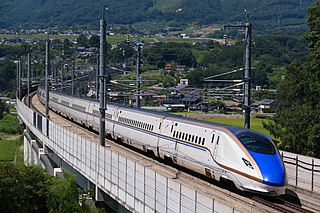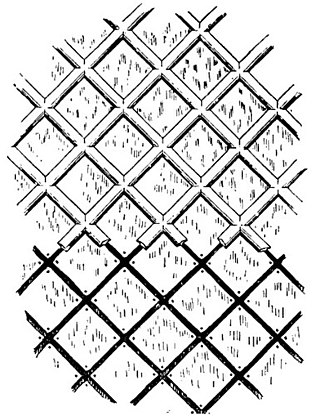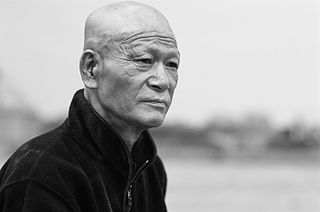
Butoh is a form of Japanese dance theatre that encompasses a diverse range of activities, techniques and motivations for dance, performance, or movement. Following World War II, butoh arose in 1959 through collaborations between its two key founders, Tatsumi Hijikata and Kazuo Ohno. The art form is known to "resist fixity" and is difficult to define; notably, founder Hijikata Tatsumi viewed the formalisation of butoh with "distress". Common features of the art form include playful and grotesque imagery, taboo topics, and extreme or absurd environments. It is traditionally performed in white body makeup with slow hyper-controlled motion. However, with time butoh groups are increasingly being formed around the world, with their various aesthetic ideals and intentions.
Takako Matsu is a Japanese actress and pop singer.

The Hokuriku Shinkansen is a high-speed Shinkansen railway line connecting Tokyo with Tsuruga in the Hokuriku region of Japan. It is jointly operated by East Japan Railway Company and West Japan Railway Company.

Shogakukan Inc. is a Japanese publisher of dictionaries, literature, comics (manga), non-fiction, DVDs, and other media in Japan.
Yoshimoto Kogyo Holdings Co., Ltd. is a Japanese entertainment conglomerate. It was founded in 1912, Osaka, as a traditional theatre, and has since grown to be one of the most influential companies in Japan, employing most of Japan's popular owarai (comedy) talent, producing and promoting the shows they appear in. The two main headquarters are stationed in Osaka and Tokyo.

The Asahi Broadcasting Group Holdings Corporation is a certified broadcasting holding company headquartered in Osaka, Japan. Until March 31, 2018, it was a unified radio and television broadcaster serving in the Kansai region. On April 1, 2018, its radio and television broadcasting divisions were spun off into two subsidiaries, with Asahi Radio Broadcasting Corporation taking over the radio broadcasting business, and Asahi Television Broadcasting Corporation took over television broadcasting.

Mainichi Broadcasting System, Inc., or MBS, is a radio and television broadcasting company headquartered in Osaka, Japan, affiliated with Japan Radio Network (JRN), National Radio Network (NRN), Japan News Network (JNN) and TBS Network, serving in the Kansai region.

Kazuo Ohno was a Japanese dancer who became a guru and inspirational figure in the dance form known as Butoh. He is the author of several books on Butoh, including The Palace Soars through the Sky, Dessin, Words of Workshop, and Food for the Soul. The latter two were published in English as Kazuo Ohno's World: From Without & Within (2004).

Seiji Maehara is a Japanese politician who is the founder and leader of Free Education for All and a member of the House of Representatives of Japan since 1993.

Ushio Amagatsu was a Japanese choreographer known as the leader of the Butoh dance group Sankai Juku, which he founded in 1975.
Ryoko Yamagishi is a Japanese manga artist. She is one of the Year 24 Group, a collection of female artists who innovated shōjo (girls') manga throughout the 1970s. Her major works include Hi Izuru Tokoro no Tenshi and Maihime Terpsichora.
Akimi Yoshida is a Japanese manga artist.

Namakowall or Namako-kabe is a Japanese wall design widely used for vernacular houses, particularly on fireproof storehouses by the latter half of the Edo period. The namako wall is distinguished by a white grid pattern on black slate. Geographically, it was most prominent in parts of western Japan, notably the San'in region and San'yō region and, from the 19th century, further east, in the Izu Peninsula.
Toshie Kihara is a Japanese manga artist and a member of the Year 24 Group. She made her professional debut in 1969 with the short story Kotchi Muite Mama! in Bessatsu Margaret. She is best known for her manga series Mari to Shingo, serialized from 1977 to 1984 in LaLa, which follows a romance between two young men at the start of the Shōwa era. Several of her manga series have inspired musicals performed by the all-female Takarazuka Revue, including Angélique, an adaptation of the novels by Anne Golon; Torikaebaya Ibun, an adaptation of the Heian era tale Torikaebaya Monogatari; and Ōeyama Kaden.

Mika Ninagawa is a Japanese photographer and director, known for her brightly colored photographs of flowers, goldfish, and landscapes.
Kiyoshi Kodama was a Japanese TV personality and actor. He hosted the Asahi Broadcasting Corporation quiz show Panel Quiz Attack 25 continuously for thirty-six years from its start in April 1975 until he was forced to step down due to poor health at the end of March 2011. His signature catchphrase on the show is "Attack Chance!"

Lost Japan is a 1993 book written by American Japonologist Alex Kerr.
Misa Yamamura, née Kimura (木村), was a Japanese novelist and a mystery writer favored as the queen of both mystery novels and tricks in Japan, often compared to Agatha Christie. Her spouse is Takashi Yamamura, a painter and a retired high school teacher. Her younger brother is Hiroshi Kimura, a professor of Political Science and her daughter is Momiji Yamamura, an actress.
Sumika Nono is a Japanese actress. She is a former top musumeyaku of the Soragumi of the Takarazuka Revue. She is nicknamed Sumika (すみか).

Kō Murobushi was a Japanese dancer and choreographer who was a leading inheritor of Tatsumi Hijikata's original vision of Butoh.











